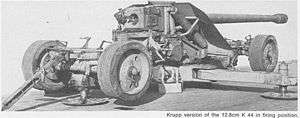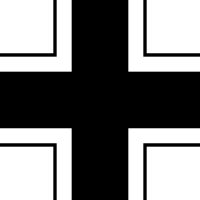12.8 cm PaK 44
| 12.8 cm Pak 44 | |
|---|---|
|
Pak 44 in firing position | |
| Type | Heavy Anti-Tank Gun |
| Place of origin | Nazi Germany |
| Service history | |
| In service | 1944—1945 |
| Used by |
|
| Wars | World War II |
| Production history | |
| Designer | Krupp |
| Designed | 1943 |
| Manufacturer | Krupp |
| Produced | 1944 |
| Number built | 51 |
| Specifications | |
| Weight | 10,160 kg (22,400 lb) |
| Barrel length | 7.023 m (20 ft) L/55 |
|
| |
| Shell | semi-fixed |
| Shell weight |
28 kg (62 lb) (HE) 28.3 kg (62 lb) (AP) |
| Caliber | 128 millimetres (5.0 in) |
| Breech | semi-automatic horizontal sliding-block |
| Recoil | Hydropneumatic |
| Carriage | cruciform (some were split trail) |
| Elevation | -7° 51' to +45° 27' |
| Traverse | 360° (some were about 90°, or less) |
| Muzzle velocity | 950 m/s (3,100 ft/s) |
| Maximum firing range | 24,410 m (26,700 yd) |
The 12.8 cm Pak 44 L/55 (PaK, (Ger.) Panzerabwehrkanone) was a German heavy anti-tank gun used during World War II. It was designed as a result of experiences on the Eastern front in 1943. The German army had encountered the Russian 122 mm guns and had issued a requirement for a similar weapon. Development initially concentrated on a field gun known as the Kanone K 44. However once heavier Russian armour such as the IS-2 started to appear the design requirements were altered to include an anti-armour role.
The Pak 44 had short to medium-range performance similar to the 8.8 cm Pak 43, but the 12.8 cm Pak 44 better maintained its anti-tank performance over long to extreme-long ranges (1800–2700+ metres) while also doubling as an effective field gun when firing HE.
Design history
The choice of 128 mm was made because of the availability of tooling due to the use of this caliber on naval weapons, design contracts being awarded to Rheinmetall Borsig and Krupp, the first prototype guns were delivered for testing in late 1944. Rheinmetall began development on a variant of the 128 mm FlaK gun, whilst Krupp opted to design a new weapon from the ground up. After initial tests the Rheinmetall design was dropped and development continued with the Krupp design. However the service tests showed that a towed anti-tank gun weighing nearly 11 tonnes was impractical so the towed design was terminated.
Approximately 50 barrels and breeches were used on existing carriages. The weapon that used the ex-French GPF-T carriage was known as the K 81/1 while the K 81/2 used the ex-Russian carriage. Both of these designs were rushed, and were too heavy, making them cumbersome to deploy. In 1943 the design was started for a gun to mount on the Jagdtiger (Sd.Kfz. 186) and the Maus super-heavy tank was started using the Pak 44 as its starting point. This weapon of which approximately 100 were made was known both as the Pak 44 and Pak 80 / Panzerjägerkanone Pjk 80. Performance was identical to the initial design.
Performance
The gun was fed with two-piece ammunition, the projectile and cartridge making up separate pieces. Because of this the gun could be fired using three different sized propellant charges, a light, medium and heavy charge. The light and medium charges were normally used when the gun was fulfilling the role of an artillery piece, where they would launch the ~28 kg projectiles to a muzzle velocity of 845 m/s and 880 m/s respectively. Finally the heavy charge was used when the gun was fulfilling its intended role as an anti-tank gun, where it fired a 28.3 kg APCBC-HE projectile (PzGr.43) at a muzzle velocity of 950 m/s. With the heavy charge, and using the PzGr.43 projectile, the Pak 44 was capable of penetrating just over 200 millimetres (7.9 in) of 30 degree sloped armor at 1000 meters, and 148 millimetres (5.8 in) at 2,000 metres (2,200 yd) range.[1]
The 12.8 cm Pak 44 ended up becoming the standard main armament for the Jagdtiger heavy tank destroyer and a tank gun variant was the planned main armament for many future super-heavy tank designs in development during the last months of World War II, including the PzKpfw VIII Maus and E-100.
Variants
- 12.8 cm Kanone 44, Pak 44
- 12.8 cm Kanone 81/1: K 44 mounted on the ex-French 155mm GPF-T carriage. 2-wheeled spit trail.
- 12.8 cm Kanone 81/2: K 44 mounted on the ex-Russian 152mm howitzer model 1937 carriage. 2-wheeled split trail.
- 12.8 cm Kanone 81/3: K 44 mounted on a Gerät 579 Medium Weapons Carriage. Krupp version. 4-wheeled version where two wheels at one end and two at the other. Firing position allows 360° traverse.
- 12.8 cm Pak 80: Pak 44 mounted on Jagdtiger (Sd.Kfz. 186) tank destroyers.
Designations
As is common at this time this weapon underwent several name changes. At various times it was known as K 44, Pak 44, Kanone 81, Pak 80 and Pjk 80.
The equipment numbered in the 8x range were temporary equipment issued usually in small numbers and not regarded as standard issue service weapons. Hence Pak 80 and Pjk 80 were temporary names as were K81/x.
Had this equipment been accepted into full service it would have had a Pak 4x designation attached. The only difference between the Pak 44 and the K 44 was mode of operation—the weapon itself was identical.
References
- ↑ "Archived copy". Archived from the original on 2014-12-14. Retrieved 2014-11-21.
- Gander, Terry and Chamberlain, Peter. Weapons of the Third Reich: An Encyclopedic Survey of All Small Arms, Artillery and Special Weapons of the German Land Forces 1939–1945. New York: Doubleday, 1979. ISBN 0-385-15090-3.
- Hogg, Ian V. German Artillery of World War Two. 2nd corrected edition. Mechanicsville, PA: Stackpole Books, 1997. ISBN 1-85367-480-X.
- Chamberlain, Peter and Doyle, Hilary. Encyclopedia of German Tanks of WWII. Orion Publishing (31 Oct 2004). ISBN 978-1-84509-012-8

